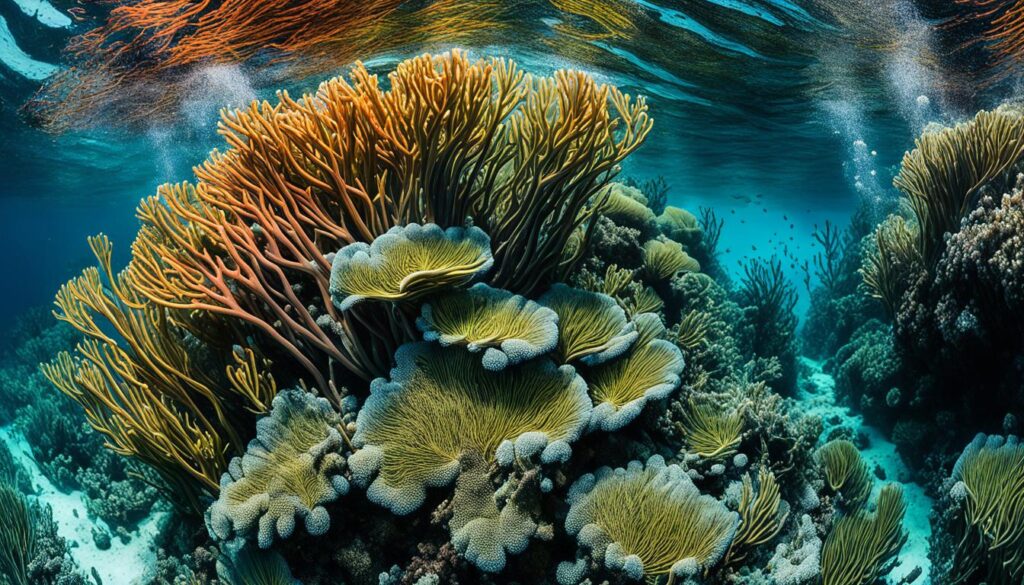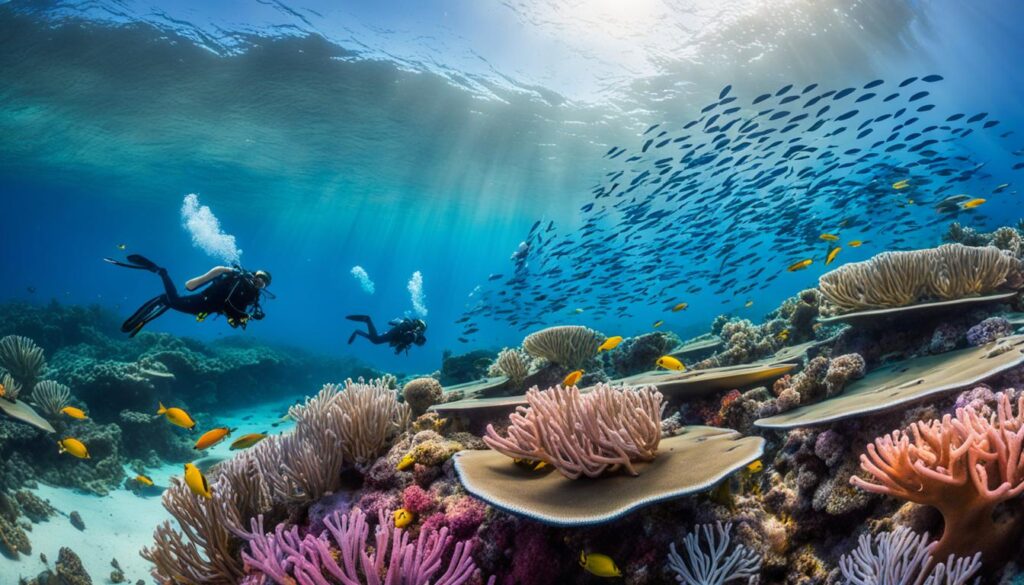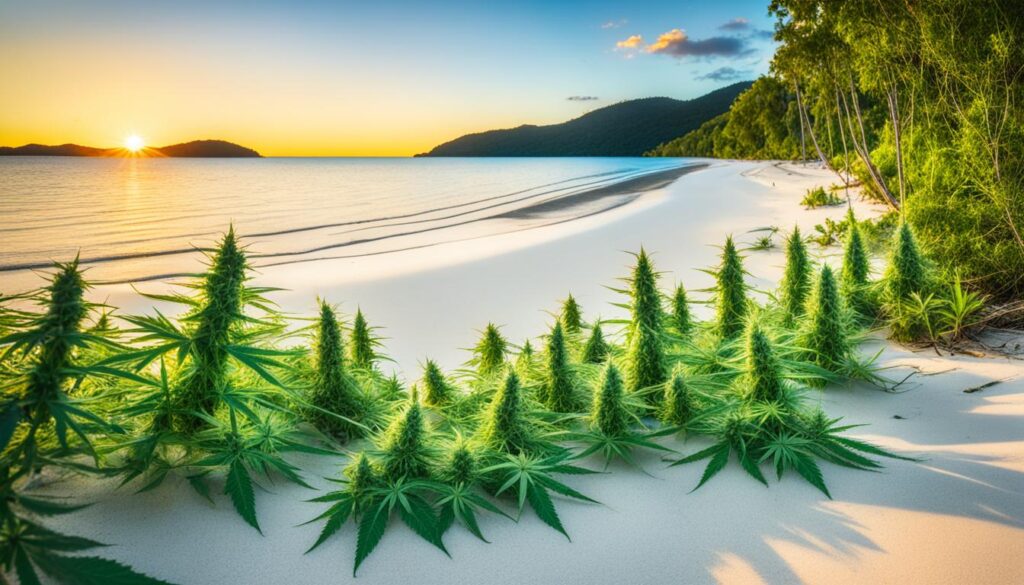The Whitsunday Islands are known for their beauty and marine life. But, they face a threat from an invasive seaweed. This article will talk about the weed’s impact, biosecurity, and conservation efforts.
The islands are in the Coral Sea and are perfect for nature lovers. You can see the famous Whitehaven Beach and the Great Barrier Reef’s marine life. But, a harmful seaweed is threatening this paradise.
Key Takeaways
- The Whitsunday Islands are facing a growing threat from an invasive seaweed species, often referred to as “weed.”
- This weed is having a significant impact on the region’s fragile marine ecosystems, including the iconic Great Barrier Reef.
- Biosecurity measures and conservation efforts are underway to address the issue and protect the Whitsunday Islands’ natural heritage.
- Understanding the environmental impact of this weed and the importance of sustainable management practices is crucial for preserving the Whitsunday Islands’ unique biodiversity.
- Visitors to the Whitsunday Islands can play a role in supporting conservation efforts by following responsible tourism guidelines and reporting any sightings of the invasive seaweed.
Introduction to the Whitsunday Islands
The Whitsunday Islands are in the Great Barrier Reef’s heart. They are a group of 74 islands off Queensland, Australia. They are famous for their beauty and are a top spot for nature lovers and tourists.
Over 70% of the islands are national or marine parks. This means they have beautiful beaches, clear waters, and green plants.
Location and Geography
The Whitsunday Islands are in the Coral Sea, part of the Great Barrier Reef Marine Park. They have a unique look, with hidden coves, tall cliffs, and famous Whitehaven Beach. This beach is seven kilometers long and has 98% silica, making it glow and stay warm.
Significance of the Whitsunday Islands
The Whitsunday Islands are very important, for nature and culture. They are home to the Ngaro people, who have lived there for over 9,000 years. They have a deep connection to the land and sea.
The Great Barrier Reef Marine Park works with the Ngaro elders to protect the islands. This shows respect for their knowledge and care for the land.
The islands help keep the Great Barrier Reef healthy. They are protected as national and marine parks. This helps save their nature and the sea life, which is good for the reef.
“The Whitsunday Islands are a true jewel in the crown of the Great Barrier Reef, offering a unique blend of natural beauty, cultural significance, and environmental preservation.”
The Invasive Seaweed Problem
The Whitsunday Islands in Australia are facing a big problem. An invasive seaweed is spreading fast. This “weed” is harming the marine life and threatens the Great Barrier Reef.
What is the Weed in Whitsunday Islands?
An exotic caulerpa seaweed is taking over in the Whitsunday Islands. It’s not from here and is hurting the native marine life. This seaweed is causing a lot of damage.
Environmental Impact and Threats
The invasive seaweed is hurting the local environment. It’s covering and killing native seagrasses and coral. This is bad news for the health of the Great Barrier Reef.
Professor Barry Scott says this seaweed could change the local ecosystems. It could harm scallops, mussels, cockles, and fish. The damage could be worse than past problems like kauri dieback and myrtle rust.
To stop it from spreading, Biosecurity New Zealand has limited boating and fishing in some areas. But getting rid of the seaweed is hard because it’s everywhere and we don’t know how to stop it.
The seaweed invasion is also hurting the local economy. Boating, fishing, and charter operations are big businesses here. So far, $5 million has been spent trying to control the seaweed.
We need a better plan to deal with this seaweed. We need to work together and get more funding for projects to stop this marine pest.
Understanding the Biosecurity Measures
The Australian government and the Great Barrier Reef Marine Park Authority have taken action. They did this because of the invasive seaweed in the Whitsunday Islands. They want to stop this plant from spreading more.
Regulations and Guidelines
Here are the main rules and guidelines:
- Boats, gear, and equipment moving between the Whitsunday Islands and the mainland must follow strict rules. This helps stop the weed from spreading.
- There are detailed programs to watch for new seaweed. They find and deal with it fast.
- Efforts are made to stop the weed from spreading. This keeps the marine life safe.
- Government agencies, local groups, and the community work together. They make sure everyone is on the same page.
These steps are key to protecting the Whitsunday Islands and the Great Barrier Reef. They keep the seaweed from causing big problems for nature and the economy.
| Biosecurity Measure | Description |
|---|---|
| Movement Restrictions | Strict rules for moving boats, gear, and equipment between the Whitsunday Islands and the mainland. This helps stop the weed from spreading. |
| Monitoring and Surveillance | There are detailed programs to quickly find new seaweed. They deal with it right away. |
| Containment and Eradication | They focus on stopping the weed from spreading. This protects the marine life. |
| Interagency Collaboration | Government agencies, local groups, and the community work together. They make sure everyone is working well. |
These biosecurity steps and regulations are very important. They help protect the Whitsunday Islands and the Great Barrier Reef from the bad effects of the invasive seaweed.
Weed in Whitsunday Islands: A Threat to Coral Reefs
The invasive seaweed in the Whitsunday Islands is a big threat to the coral reefs. This weed grows fast and takes over, killing the coral. This hurts the health and strength of the reef.
This weed is a big problem for the Great Barrier Reef, which includes the Whitsunday Islands. A lot of the inshore reef is now covered in this seaweed. It comes from too much phosphate and soil from farms.
The Whitsunday Islands are in a special area of Queensland. They are home to a small part of the state’s people. Over the years, they’ve faced many problems like bleaching and pollution from farms.
The invasive seaweed is now another big threat. It’s bad news for the delicate ecosystems of the Great Barrier Reef.
| Statistic | Value |
|---|---|
| Tourism enterprises on the Great Barrier Reef employ more than | 63,000 people |
| The Great Barrier Reef spans over | 3000km (1800 miles) |
| The Reef comprises over | 3000 individual reef systems and coral cays and hundreds of tropical islands |
| Average temperatures across Queensland have increased by | 1°C over the past 100 years |
| By 2030, under a high emissions scenario, the climate of Mackay is projected to become more like the current climate of | Proserpine |
The invasive seaweed in the Whitsunday Islands is a big threat to the coral reef. It kills the coral and makes the reef weaker. This is bad news for the Great Barrier Reef, which is important for the environment and economy.

The Great Barrier Reef and Marine Pest Invasion
The Great Barrier Reef is a huge and important place under the sea. It’s where many different kinds of sea life live. This includes colorful coral, lots of fish, and other creatures that make it special.
This place is key for the local area and helps the whole world’s oceans.
Significance of the Great Barrier Reef
The Great Barrier Reef is a big wonder, stretching over 2,300 kilometers in Queensland, Australia. It’s the biggest coral reef system in the world and a UNESCO World Heritage Site. People know it for its beauty and its role in nature.
It’s a home for many fish, sea turtles, sharks, and other sea creatures.
Consequences of Invasive Seaweed
Invasive seaweed in the Whitsunday Islands is a big problem for the Great Barrier Reef. This seaweed can take over and harm the native sea life. It can even kill the coral that the reef needs.
This can make the reef unhealthy and lose many species. It could also make the reef less strong against problems like pollution.
This seaweed issue can affect the whole ocean. It can change the balance of nature and harm the reef’s health. This could lead to losing species and hurting the ocean’s health worldwide.
“The Great Barrier Reef is a natural wonder of the world, and its protection is essential for the health of our planet’s marine ecosystems.”
Aquatic Ecosystem Conservation Efforts
The Whitsunday Islands and the Great Barrier Reef are full of life but face a big threat. Non-native seaweed is taking over. Conservation groups are working hard to save this special place.
They are watching closely with monitoring and surveillance programs. These programs check on the seaweed and protect the native sea life. This way, they can act fast if something new shows up.
They also teach people why the Whitsunday Islands matter. They tell everyone how the seaweed is a danger. They want people to help keep the area safe.
They have strict rules to stop the seaweed from spreading. Boats and gear get cleaned well. They also make sure no new harmful plants or animals get in.
| Conservation Effort | Key Achievements |
|---|---|
| Monitoring and Surveillance Programs | Tracked the spread of invasive seaweed and identified emerging threats to marine life |
| Public Education Campaigns | Raised awareness about the importance of the aquatic ecosystem and encouraged sustainable practices |
| Biosecurity Measures | Implemented cleaning protocols and regulations to prevent the further spread of the invasive seaweed |
Together, we can save the Whitsunday Islands’ delicate ecosystem. Let’s keep this amazing place safe for the future.

“The Whitsunday Islands are a true natural wonder, and we must do everything in our power to safeguard their fragile ecosystem. By working collectively, we can make a real difference in protecting this incredible marine environment.”
Coastal Management Strategies
The Australian government and the Great Barrier Reef Marine Park Authority have set up coastal management strategies to tackle the invasive seaweed in the Whitsunday Islands. These plans focus on stopping and controlling the seaweed. They also promote sustainable tourism to protect the area’s marine life.
Prevention and Control Measures
To stop the seaweed from spreading, strict rules for boats and gear have been made. Early detection and quick action are used to find and stop new seaweed outbreaks. This way, the risk of the seaweed moving to new places is lowered.
Sustainable Tourism Practices
Managing the Whitsunday Islands also means promoting sustainable tourism practices. Visitors learn why the marine life is important and how to reduce their impact. Steps are taken to make sure tourism doesn’t spread the invasive seaweed, like biosecurity protocols for gear and boats.
“Protecting the Whitsunday Islands and the Great Barrier Reef is not just about managing the invasive seaweed. It’s about fostering a sustainable relationship between tourism, the local community, and the natural environment.”
With a plan that includes prevention, control, and sustainable tourism, the Whitsunday Islands aim to protect their marine ecosystems. This ensures they can thrive for a long time.
Raising Awareness and Community Involvement
We are fighting against invasive seaweed in the Whitsunday Islands. It’s important to teach people about it. This way, everyone can help solve the problem.
There are many educational programs. They teach people about the dangers of the weed. They also talk about why we need to protect the Whitsunday Islands and the Great Barrier Reef.
People are learning to watch out for the weed. They are told to report it and help clean it up. This is how we can all make a difference.
Groups like the Whitsunday Conservation Council and the Whitsunday Catchment Landcare lead these efforts. They plan beach cleanups and science projects. They also let people help with data and monitoring.
| Organization | Focus | Key Activities |
|---|---|---|
| Whitsunday Conservation Council | Protecting the environment |
|
| Whitsunday Catchment Landcare | Sustainable land use |
|
These efforts aim to make people feel like they own the Whitsunday Islands. They want everyone to take care of it. By working together, we can beat the invasive seaweed. This will help keep the area safe for the future.
Species Conservation and Restoration Programs
There are special programs to protect and bring back species in the Whitsunday Islands and the Great Barrier Reef. These programs watch over and help species that are in danger. They also work to fix and bring back native marine life where the seaweed has taken over.
The Reef Assist 1.0 program helped create over 230 jobs. About half of these jobs went to First Nations people, over a third to young people, and a fifth to women. The program offered more than 110 different training courses, including many formal qualifications.
- Around 155,000 native seedlings were planted as part of the conservation efforts.
- Over 300 hectares of revegetation were completed.
- More than 215,000 native seeds were collected for propagation.
- Weeds were removed from over 660 hectares of land.
- A total of 1,025 kilograms of marine debris were collected.
The Reef Islands Initiative (RII) is a $14 million, 10-year program. It aims to protect and fix important island habitats in the Great Barrier Reef. This program has made a big difference, like increasing turtle nesting areas by 125% on Lady Elliot Island.
It has also put over 300 million coral larvae and 4,525 coral fragments on the reef to help it heal in the Whitsundays.
The RII has helped seven Traditional Owners get back to their land. They share their culture and manage the land with fire. On Munamudanamy (Hinchinbrook Island), it’s working with indigenous groups to improve island care and conservation.
These programs show how hard people are working to save the unique and delicate ecosystems of the Whitsunday Islands and the Great Barrier Reef. They help keep the area’s diverse marine life safe for the future.
Conclusion
The Whitsunday Islands are a true wonder of nature. They have a diverse and fragile marine life that is in danger. The Australian government and the Great Barrier Reef Marine Park Authority are fighting to save them.
They are using many ways to help, like biosecurity, sustainable tourism, and getting the community involved. By spreading the word and acting, we can keep the Whitsunday Islands safe for the future.
The Reef Islands Initiative is a $14 million program to protect and fix island habitats. It shows how much we care about keeping the Great Barrier Reef, including the Whitsunday Islands, beautiful and healthy.
We all need to help protect the Whitsunday Islands and the Great Barrier Reef. We can do this through conservation, teaching others, and being responsible. Together, we can save this amazing place for everyone to enjoy.

As a veteran weed smoker for over 30 years and been very clean for the last 3 years, I have been craving it.
One thing I’ve never done is consume it?
I came across SunJet Plug and thought mmmm how esp with legalities etc.
So I made the plunge and purchased 12 brownies, well within 30 mins it kicked in and it was immense as I had a whole one from the off 😜
The rest did not last a week I was having 2 a day and my wife lost me for a few days I was in my own world apparently.
Kudos to the Sunjet plug love em, the taste is a bit undesirable could do with a tweak or two other than that no complaints
Contact him on his telegram link: t.me/sunjetplug
His email : sunjetplug@gmail.com
Many many thanks.😁
Take note ,he does not have telegram channels
Sunjet plug is 100% legit.. I’m a repeat customer.. I’ve ordered 10+ times now, and I’ve never had an issue.. Great product, great service.
Sunjet plug is extremely trust worthy , they never fail in what ever product I order, and its always in my hands with an hour of ordering 99% of the time….. its honestly rare when its more than 2 hours and that’s only because its the weekend when ive orded or a national holiday is on or something lol …. brilliant service I’m probably pushing maybe 2 months with them and I’ve never been disappointed ❤️ my only recommendation would maybe do a stamp card to get something free after 5 orders or a loyalty bonus of some kind ❤️
Email sunjet.. sunjetplug@gmail.com